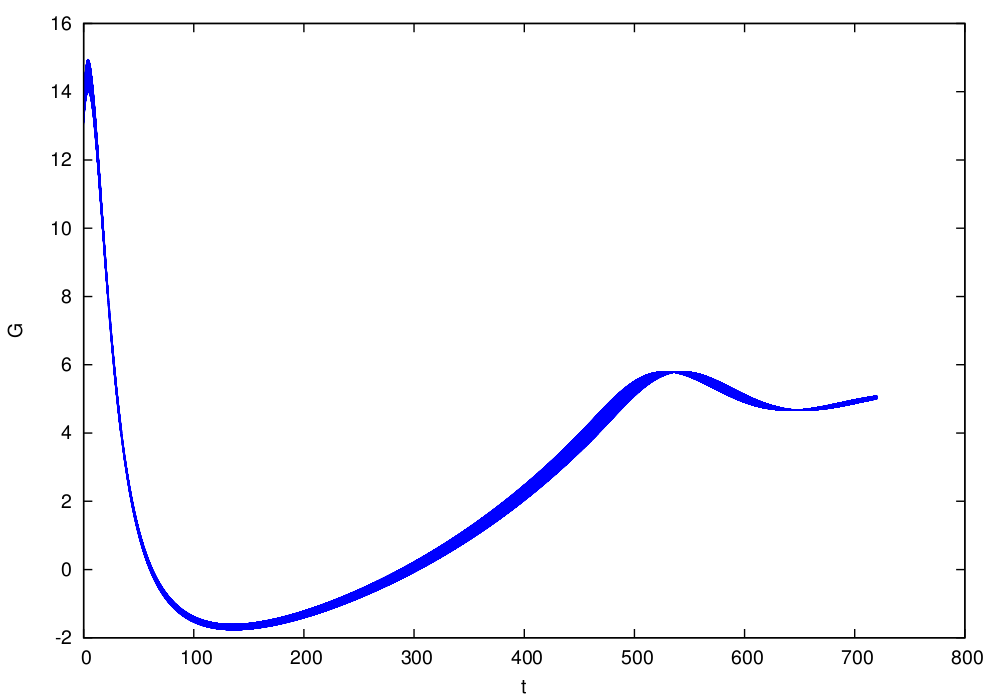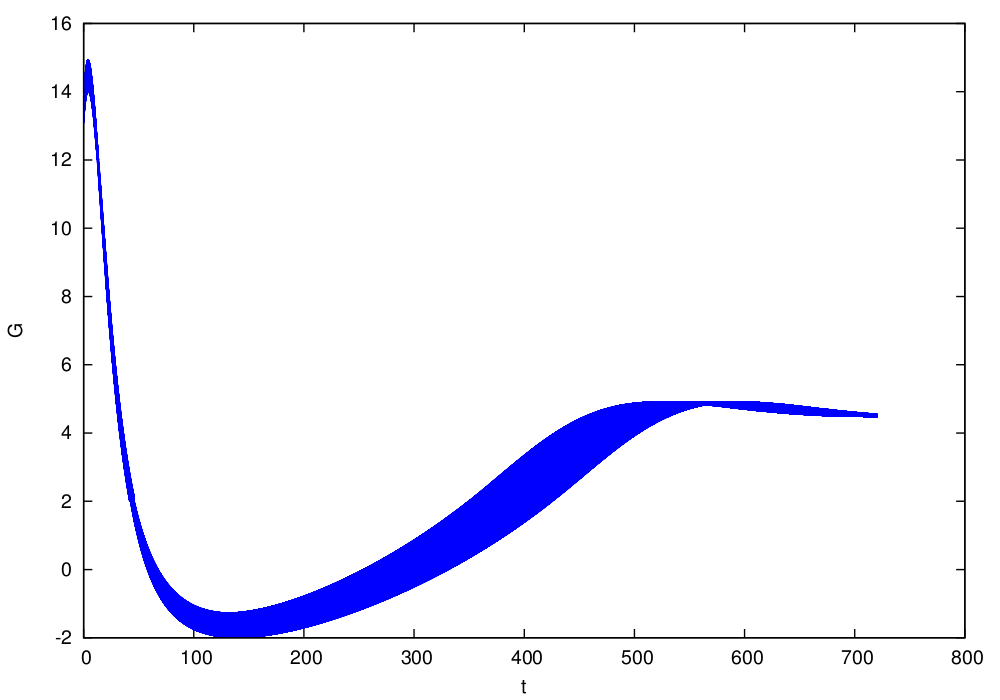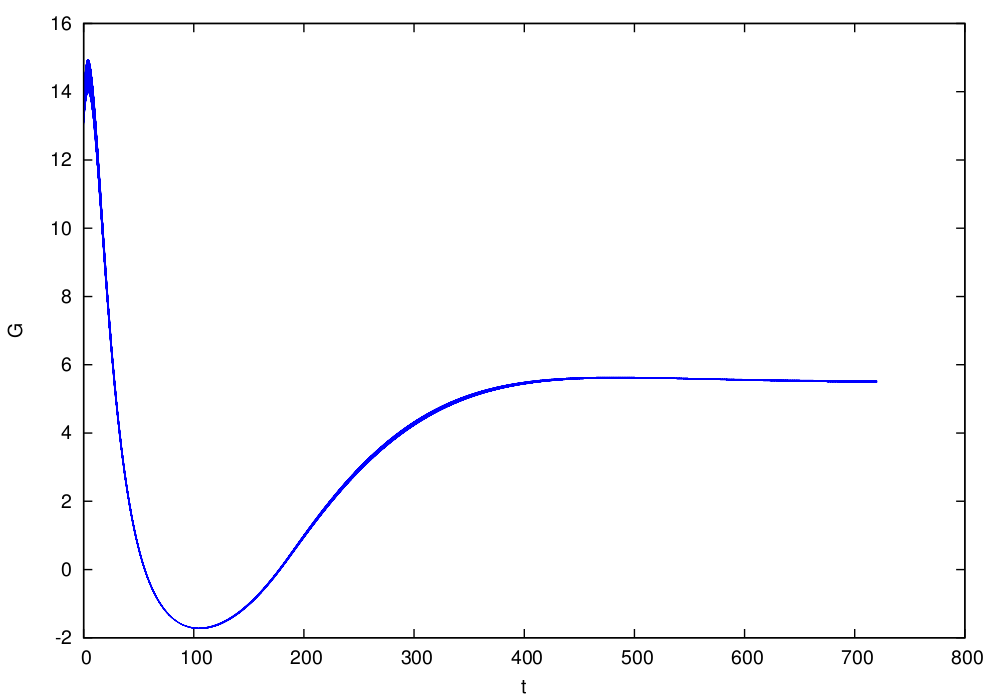Classification
| # of variables | # of modes | # of jumps |
|---|---|---|
| 4 | 2-3 | 1-4 |
| Type | Continuous dynamics | Guards & Invariants | Resets |
|---|---|---|---|
| hybrid | non-polynomial | linear polynomial | identity |
Download
| Flow* Strategy I | glucose_control_I |
| Flow* Strategy II | glucose_control_II |
| Flow* Strategy III | glucose_control_III |
Model description
We study the “minimal model” defined in [1-3] for the dynamics of glucose and insulin interaction in the blood system. It is described by the following ODE.
![Rendered by QuickLaTeX.com \[ \left\{ \begin{array}{lcl} \dot{G} & = & -p_1 \cdot G - X\cdot(G + G_B) + P \\ \dot{X} & = & -p_2\cdot X + p_3\cdot I \\ \dot{I} & = & -n\cdot (I + I_B) + \frac{u}{V_I} \end{array} \right. \]](https://ths.rwth-aachen.de/wp-content/ql-cache/quicklatex.com-c1c8b9ba0ce9bddcac2f45388860407c_l3.png)
wherein ![]() are constant parameters whose typical values are
are constant parameters whose typical values are ![]() min
min![]() ,
, ![]() min
min![]() and
and ![]() min
min![]() U
U![]() L. The values of
L. The values of ![]() and
and ![]() are the basal values of plasma glucose concentration and free plasma insulin concentration respectively, and they are given by
are the basal values of plasma glucose concentration and free plasma insulin concentration respectively, and they are given by ![]() mmol L
mmol L![]() ,
, ![]() U L
U L![]() . The constant
. The constant ![]() is the insulin distribution volume, and the value of
is the insulin distribution volume, and the value of ![]() denotes the fractional disappearance rate of insulin. We take their values as
denotes the fractional disappearance rate of insulin. We take their values as ![]() L and
L and ![]() min
min![]() . The remaining parameters are variables, we give their explanations as below.
. The remaining parameters are variables, we give their explanations as below.
| the difference of plasma glucose concentration | |
| the free plasma insulin concentration | |
| the insulin concentration in an interstitial chamber | |
| the rate of infusion of exogeneous glucose | |
| the rate of infusion of exogeneous insulin |
We use the formulation ![]() given in [4] for the rate of insulin infusion, and consider three different strategies for the insulin delivery rate
given in [4] for the rate of insulin infusion, and consider three different strategies for the insulin delivery rate ![]() .
.
Strategy I is proposed in [5].
The rate ![]() is
is ![]() U h
U h![]() when
when ![]() mmol L
mmol L![]() ,
,
and it is ![]() U h
U h![]() when
when ![]() mmol L
mmol L![]() .
.
If ![]() is in the range from
is in the range from ![]() to
to ![]() mmol L
mmol L![]() , we use
, we use ![]() U h
U h![]() which is a linear transition between the rates
which is a linear transition between the rates ![]() and
and ![]() mmol L
mmol L![]() .
.
Strategy II is taken from [6], it is similar to Strategy I but considers the rates ![]() and
and ![]() mmol L
mmol L![]() .
.
That is, we set ![]() U h
U h![]() when
when ![]() mmol L
mmol L![]() ,
,
and ![]() U h
U h![]() when
when ![]() mmol L
mmol L![]() .
.
For the case that ![]() is between
is between ![]() and
and ![]() mmol L
mmol L![]() ,
, ![]() is defined by
is defined by ![]() .
.
In order to better stabilize the glucose level, a more sophisticated control strategy is presented in [6]. We call it Strategy III. The controller reads the value of ![]() in the beginning of every
in the beginning of every ![]() hours and do the following job.
hours and do the following job.
If ![]() mmol L
mmol L![]() , then we use the input rate
, then we use the input rate ![]() U min
U min![]() .
.
Otherwise ![]() is set to be the linear form
is set to be the linear form ![]() U min
U min![]() .
.
Reachability settings
We consider the initial condition ![]() ,
, ![]() , and
, and ![]() under all control strategies.
under all control strategies.
Results
An over-approximation computed by Flow* for Strategy I is shown below. The time horizon is ![]() :
:

Similarly, we show the figures of the overapproximations computed by Flow* for Strategy II and Strategy III.
References
[1] R. Bergman, Y. Ider, C. Bowden, C. Cobelli. Quantitative estimation of insulin sensitivity. In The American Journal of Physiology, volume 236, pages 667-677, The American Physiological Society, 1979. [2] R. Bergman, L. Phillips, C. Cobelli. Physiologic evaluation of factors controlling glucose tolerance in man: measurement of insulin sensitivity and1991. [5] D. Chisholm, E. Kraegen, D. Bell, D. Chipps. A semiclosed loop computer-assisted insulin infusion system. In The Medical journal of Australia, volume 141, pages 784–789, Australasian Medical Publishing Company Proprietary Limited, 1984. [6] S. Furler, E. Kraegen, R. Smallwood, D. Chisholm. Blood glucose control by intermittent loop closure in the basal mode: computer simulation studies with a diabetic model. In Diabetes Care, volume 8, pages 553–561, American Diabetes Association, 1985.

